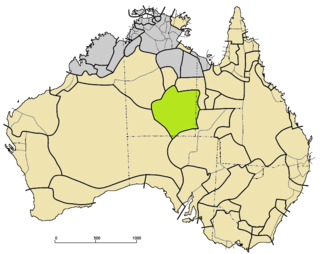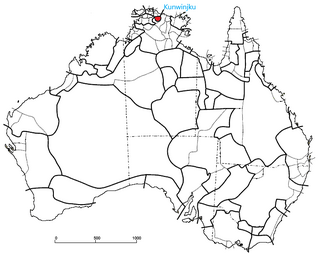History of contact
European penetration of Kaytetye country began with John Stuart's early explorations from 1860 onwards and his subsequent survey of the area for the purposes of installing an Overland Telegraph.
The two cultures did not initially integrate peacefully. In 1874, European settlers stationed at the Barrow Creek telegraph station are said to have infringed tribal laws regarding either sacred sites or women, and in reprisal Kaytetye men attacked the station, killing two whites. This sparked revenge killings by constables and settlers, who, acting in line with an inspector's suggestion that, "the close adherence to legal forms should not be insisted upon," carried out a savage series of retaliatory killings that decimated the Kaitetye, though affecting contiguous tribes as well. Official reports say only two Aboriginals were killed. Unofficial figures suggest the numbers went as high as 50-90, with some make an overall estimate of hundreds. The bones of Kaitetye people slaughtered in one such raid at the time, at Skull Creek, were visible for decades afterwards.
After the 1890s Kaytetye confrontations with whites became rarer. Later, in the widely known Coniston massacre of 1928, a series of three punitive raids occurred over a number of weeks as a police party of 8 men under Mounted Police Constable George Murray killed, according to a later inquiry, at least 31 Kaytetye, Warlpiri and Anmatyerre indiscriminately, though native oral records suggest a higher figure.
Kaytetye people worked alongside European settlers for years to come in pastoral and mining capacities but were not treated equally until the period of World War 2 in which an army settlement was established near Barrow Creek. Many Kaytetye men and women were employed and were treated fairly for the first time, making it difficult for pastoral stations to keep their Indigenous workers on the station. This forced a change the way Kaytetye pastoral workers were treated. Both the mining employment and the army settlement were temporary engagements, leaving the Kaytetye only pastoral work if they desired to stay in their country.
Kaytetye call the area around Barrow Creek Thangkenharenge which includes the site of their creation story at Elkerempelkere. Traditionally, the Kaytetye people maintain their connection to the sacred sites like Elkerempelkere. The Devils Marbles, which the Kaytetye call Karlu Karlu, are located on a sacred Dreaming site. It has been desecrated by whites on occasion. Granite was removed from the site for the tomb commemorating John Flynn, the 'Flying Doctor'. though subsequently restored under protest.
Karlu Karlu / Devils Marbles Conservation Reserve is a protected area in the Northern Territory of Australia located in the locality of Warumungu about 105 km (65 mi) south of Tennant Creek, and 393 km (244 mi) north of Alice Springs. The nearest settlement is the small town of Wauchope located 9 km (5.6 mi) to the south.

The Warlpiri, sometimes referred to as Yapa, are a group of Aboriginal Australians defined by their Warlpiri language, although not all still speak it. There are 5,000–6,000 Warlpiri, living mostly in a few towns and settlements scattered through their traditional land in the Northern Territory, north and west of Alice Springs. About 3,000 still speak the Warlpiri language. The word "Warlpiri" has also been romanised as Walpiri, Walbiri, Elpira, Ilpara, and Wailbri.
The Alyawarre, also spelt Alyawarr and also known as the Iliaura, are an Aboriginal Australian people, or language group, from the Northern Territory. The Alyawarre are made up of roughly 1,200 associated peoples and actively engage in local traditions such as awelye painting.
The Coniston massacre, which took place in the region around the Coniston cattle station in the then Territory of Central Australia from 14 August to 18 October 1928, was the last known officially sanctioned massacre of Indigenous Australians and one of the last events of the Australian Frontier Wars.
The Pintupi are an Australian Aboriginal group who are part of the Western Desert cultural group and whose traditional land is in the area west of Lake Macdonald and Lake Mackay in Western Australia. These people moved into the Aboriginal communities of Papunya and Haasts Bluff in the west of the Northern Territory in the 1940s–1980s. The last Pintupi to leave their traditional lifestyle in the desert, in 1984, are a group known as the Pintupi Nine, also sometimes called the "lost tribe".
Ngardi, also spelt Ngarti or Ngardilj, is an Australian Aboriginal language that is considered moribund. It was previously thought to be an alternative name for the Bunara language, but these are now classified as separate languages. It was/is spoken by the Ngarti people of the Northern Territory and northern Western Australia.

Arrernte or Aranda or sometimes referred to as Upper Arrernte, is a dialect cluster in the Arandic language group spoken in parts of the Northern Territory, Australia, by the Arrernte people. Other spelling variations are Arunta or Arrarnta, and all of the dialects have multiple other names.
The Gurindji are an Aboriginal Australian people of northern Australia, 460 kilometres (290 mi) southwest of Katherine in the Northern Territory's Victoria River region.
The Warumungu are a group of Aboriginal Australians of the Northern Territory. Today, Warumungu are mainly concentrated in the region of Tennant Creek and Alice Springs.

Arandic is a family of Australian Aboriginal languages consisting of several languages or dialect clusters, including the Arrernte group, Lower Arrernte, Pertame language and Kaytetye.
The Anmatyerre are an Aboriginal Australian people of the Northern Territory, who speak one of the Upper Arrernte languages.

The Gunwinggu (Kunwinjku) people are an Australian Aboriginal people, one of several groups within the Bininj people, who live around West Arnhem Land to the east of Darwin, Northern Territory. Kunwinjku people generally refer to themselves as "Bininj" in much the same way that Yolŋu people refer to themselves as "Yolŋu".

Kaytetye is an Australian Aboriginal language spoken in the Northern Territory north of Alice Springs by the Kaytetye people, who live around Barrow Creek and Tennant Creek. It belongs to the Arandic subgroup of the Pama-Nyungan languages and is related to Alyawarra, which is one of the Upper Arrernte dialects. It has an unusual phonology and there are no known dialects.
The Erawirung people, also known as Yirau, Juju and other names, were an Aboriginal Australian people whose traditional territory was located in what is today the Riverland of South Australia. They consisted of sub-groups or clans, including Jeraruk, Rankbirit and Wilu, and have been referred to as Meru people, which was a larger grouping which could also include the Ngawait and Ngaiawang peoples.
The Bininj are an Aboriginal Australian people of Western Arnhem land in the Northern Territory. The sub-groups of Bininj are sometimes referred to by the various language dialects spoken in the region, that is, the group of dialects known as Bininj Gun-Wok; so the people may be named Gunwinggu, the Kuninjku, Kundjeyhmi (Gundjeihmi), Manyallaluk Mayali, Kundedjnjenghmi and Kune groups.
The Gajirrawoong people, also written Gadjerong, Gajerrong and other variations, are an Aboriginal Australian people of the Northern Territory, most of whom now live in north-eastern Western Australia.
The Djaru people are an indigenous Australian people of the southern Kimberley region of Western Australia.
The Luritja or Loritja people, also known as Kukatja or Kukatja-Luritja, are an Aboriginal Australian people of the Northern Territory. Their traditional lands are immediately west of the Derwent River, that forms a frontier with the Arrernte people, with their lands covering some 27,000 square kilometres (10,300 sq mi). Their language is the Luritja dialect, a Western Desert language.
The Ngaliya (Ngalia) are an indigenous Australian people of the Northern Territory who speak a dialect of the Warlpiri language. They are not to be confused with the Ngalia of the Western Desert.

Ali Curung is an Indigenous Australian community in the Barkly Region of the Northern Territory. The community is located 170 km (106 mi) south of Tennant Creek, and 378 km (235 mi) north of Alice Springs. At the 2016 census, the community had a population of 494.





